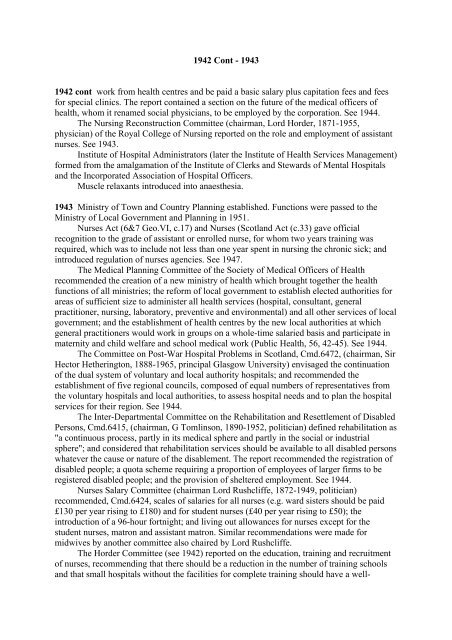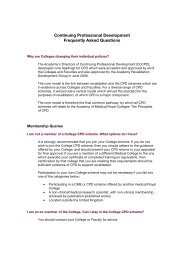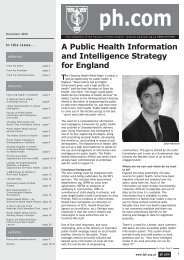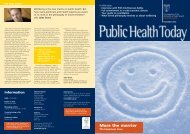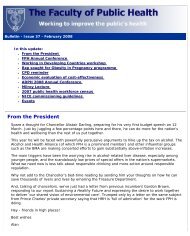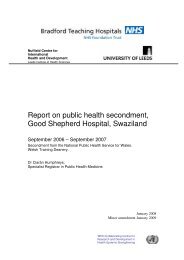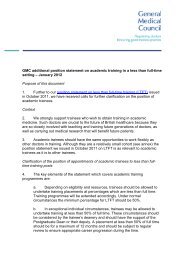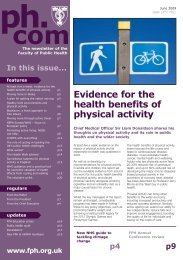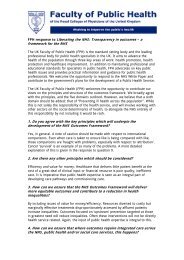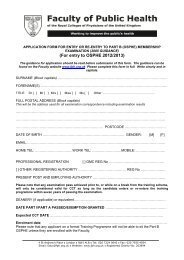A Chronology of State Medicine, Public Health, Welfare and Related ...
A Chronology of State Medicine, Public Health, Welfare and Related ...
A Chronology of State Medicine, Public Health, Welfare and Related ...
You also want an ePaper? Increase the reach of your titles
YUMPU automatically turns print PDFs into web optimized ePapers that Google loves.
1942 Cont - 1943<br />
1942 cont work from health centres <strong>and</strong> be paid a basic salary plus capitation fees <strong>and</strong> fees<br />
for special clinics. The report contained a section on the future <strong>of</strong> the medical <strong>of</strong>ficers <strong>of</strong><br />
health, whom it renamed social physicians, to be employed by the corporation. See 1944.<br />
The Nursing Reconstruction Committee (chairman, Lord Horder, 1871-1955,<br />
physician) <strong>of</strong> the Royal College <strong>of</strong> Nursing reported on the role <strong>and</strong> employment <strong>of</strong> assistant<br />
nurses. See 1943.<br />
Institute <strong>of</strong> Hospital Administrators (later the Institute <strong>of</strong> <strong>Health</strong> Services Management)<br />
formed from the amalgamation <strong>of</strong> the Institute <strong>of</strong> Clerks <strong>and</strong> Stewards <strong>of</strong> Mental Hospitals<br />
<strong>and</strong> the Incorporated Association <strong>of</strong> Hospital Officers.<br />
Muscle relaxants introduced into anaesthesia.<br />
1943 Ministry <strong>of</strong> Town <strong>and</strong> Country Planning established. Functions were passed to the<br />
Ministry <strong>of</strong> Local Government <strong>and</strong> Planning in 1951.<br />
Nurses Act (6&7 Geo.VI, c.17) <strong>and</strong> Nurses (Scotl<strong>and</strong> Act (c.33) gave <strong>of</strong>ficial<br />
recognition to the grade <strong>of</strong> assistant or enrolled nurse, for whom two years training was<br />
required, which was to include not less than one year spent in nursing the chronic sick; <strong>and</strong><br />
introduced regulation <strong>of</strong> nurses agencies. See 1947.<br />
The Medical Planning Committee <strong>of</strong> the Society <strong>of</strong> Medical Officers <strong>of</strong> <strong>Health</strong><br />
recommended the creation <strong>of</strong> a new ministry <strong>of</strong> health which brought together the health<br />
functions <strong>of</strong> all ministries; the reform <strong>of</strong> local government to establish elected authorities for<br />
areas <strong>of</strong> sufficient size to administer all health services (hospital, consultant, general<br />
practitioner, nursing, laboratory, preventive <strong>and</strong> environmental) <strong>and</strong> all other services <strong>of</strong> local<br />
government; <strong>and</strong> the establishment <strong>of</strong> health centres by the new local authorities at which<br />
general practitioners would work in groups on a whole-time salaried basis <strong>and</strong> participate in<br />
maternity <strong>and</strong> child welfare <strong>and</strong> school medical work (<strong>Public</strong> <strong>Health</strong>, 56, 42-45). See 1944.<br />
The Committee on Post-War Hospital Problems in Scotl<strong>and</strong>, Cmd.6472, (chairman, Sir<br />
Hector Hetherington, 1888-1965, principal Glasgow University) envisaged the continuation<br />
<strong>of</strong> the dual system <strong>of</strong> voluntary <strong>and</strong> local authority hospitals; <strong>and</strong> recommended the<br />
establishment <strong>of</strong> five regional councils, composed <strong>of</strong> equal numbers <strong>of</strong> representatives from<br />
the voluntary hospitals <strong>and</strong> local authorities, to assess hospital needs <strong>and</strong> to plan the hospital<br />
services for their region. See 1944.<br />
The Inter-Departmental Committee on the Rehabilitation <strong>and</strong> Resettlement <strong>of</strong> Disabled<br />
Persons, Cmd.6415, (chairman, G Tomlinson, 1890-1952, politician) defined rehabilitation as<br />
"a continuous process, partly in its medical sphere <strong>and</strong> partly in the social or industrial<br />
sphere"; <strong>and</strong> considered that rehabilitation services should be available to all disabled persons<br />
whatever the cause or nature <strong>of</strong> the disablement. The report recommended the registration <strong>of</strong><br />
disabled people; a quota scheme requiring a proportion <strong>of</strong> employees <strong>of</strong> larger firms to be<br />
registered disabled people; <strong>and</strong> the provision <strong>of</strong> sheltered employment. See 1944.<br />
Nurses Salary Committee (chairman Lord Rushcliffe, 1872-1949, politician)<br />
recommended, Cmd.6424, scales <strong>of</strong> salaries for all nurses (e.g. ward sisters should be paid<br />
£130 per year rising to £180) <strong>and</strong> for student nurses (£40 per year rising to £50); the<br />
introduction <strong>of</strong> a 96-hour fortnight; <strong>and</strong> living out allowances for nurses except for the<br />
student nurses, matron <strong>and</strong> assistant matron. Similar recommendations were made for<br />
midwives by another committee also chaired by Lord Rushcliffe.<br />
The Horder Committee (see 1942) reported on the education, training <strong>and</strong> recruitment<br />
<strong>of</strong> nurses, recommending that there should be a reduction in the number <strong>of</strong> training schools<br />
<strong>and</strong> that small hospitals without the facilities for complete training should have a well-


